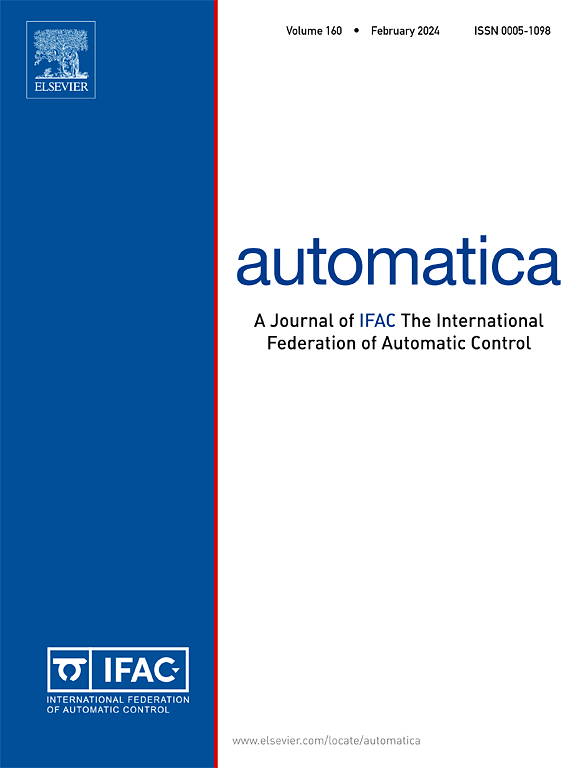基于广义奇异值分解的多阵交叉系统控制
IF 4.8
2区 计算机科学
Q1 AUTOMATION & CONTROL SYSTEMS
引用次数: 0
摘要
钻石光源通过将电子加速到相对论速度来产生同步辐射。为了最大限度地提高辐射强度,电子束的振动通过多输入多输出(MIMO)控制系统以超过10千赫的速率驱动数百个磁体来衰减。对于未来的加速器配置,两组不同带宽和约束条件的磁体组合使用,标准的加速器控制设计方法是不合适的。为了解决这个问题,我们开发了一种基于广义奇异值分解(GSVD)的转换,将双阵列交叉方向(CD)动力学解耦为双输入单输出(TISO)和单输入单输出(SISO)系统集。这种转换允许使用SISO和TISO方法在模态空间中设计控制器,并分别调整到每个执行器阵列。通过引入静态补偿器矩阵来补偿GSVD的非正交性和潜在的病态响应矩阵。这种方法可以实现一个简单的控制器结构,以满足Diamond未来配置的100 kHz采样频率,其中包含252个输出和396个输入。基于gsvd的设计在Diamond的实际实验中得到了实现和验证。我们的方法为单阵列系统提供了模态分解的自然扩展,并且在其他CD系统中有潜在的应用,包括造纸、轧钢或电池制造过程。本文章由计算机程序翻译,如有差异,请以英文原文为准。
Control of multi-array cross-directional systems using the generalised singular value decomposition
Diamond Light Source produces synchrotron radiation by accelerating electrons to relativistic speeds. In order to maximise the intensity of the radiation, vibrations of the electron beam are attenuated by a multi-input multi-output (MIMO) control system actuating hundreds of magnets at rates exceeding 10 kHz. For future accelerator configurations, in which two separate arrays of magnets with different bandwidths and constraints are used in combination, standard accelerator control design methods are not suitable. To address this, we develop a transformation based on the generalised singular value decomposition (GSVD) to decouple the two-array cross-directional (CD) dynamics into sets of two-input single-output (TISO) and single-input single-output (SISO) systems. This transformation allows the controller to be designed in modal space using SISO and TISO methods and to be tuned to each actuator array separately. The non-orthogonality of the GSVD and potentially ill-conditioned response matrices are compensated for by incorporating static compensator matrices. This approach results in a simple controller structure that can be implemented to meet the 100 kHz sampling frequency of the Diamond’s future configuration with 252 outputs and 396 inputs. The GSVD-based design is implemented and validated through real-world experiments at Diamond. Our approach provides a natural extension of the modal decomposition for single-array systems and has potential application in other CD systems, including paper making, steel rolling, or battery manufacturing processes.
求助全文
通过发布文献求助,成功后即可免费获取论文全文。
去求助
来源期刊

Automatica
工程技术-工程:电子与电气
CiteScore
10.70
自引率
7.80%
发文量
617
审稿时长
5 months
期刊介绍:
Automatica is a leading archival publication in the field of systems and control. The field encompasses today a broad set of areas and topics, and is thriving not only within itself but also in terms of its impact on other fields, such as communications, computers, biology, energy and economics. Since its inception in 1963, Automatica has kept abreast with the evolution of the field over the years, and has emerged as a leading publication driving the trends in the field.
After being founded in 1963, Automatica became a journal of the International Federation of Automatic Control (IFAC) in 1969. It features a characteristic blend of theoretical and applied papers of archival, lasting value, reporting cutting edge research results by authors across the globe. It features articles in distinct categories, including regular, brief and survey papers, technical communiqués, correspondence items, as well as reviews on published books of interest to the readership. It occasionally publishes special issues on emerging new topics or established mature topics of interest to a broad audience.
Automatica solicits original high-quality contributions in all the categories listed above, and in all areas of systems and control interpreted in a broad sense and evolving constantly. They may be submitted directly to a subject editor or to the Editor-in-Chief if not sure about the subject area. Editorial procedures in place assure careful, fair, and prompt handling of all submitted articles. Accepted papers appear in the journal in the shortest time feasible given production time constraints.
 求助内容:
求助内容: 应助结果提醒方式:
应助结果提醒方式:


